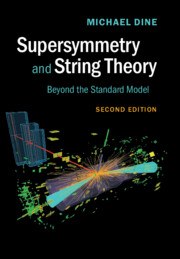Book contents
- Frontmatter
- Dedication
- Contents
- Preface to the First Edition
- Preface to the Second Edition
- A note on the choice of metric
- Text website
- Part 1 Effective field theory: the StandardModel, supersymmetry, unification
- Part 2 Supersymmetry
- Part 3 String theory
- 20 Introduction
- 21 The bosonic string
- 22 The superstring
- 23 The heterotic string
- 24 Effective actions in ten dimensions
- 25 Compactification of string theory I. Tori and orbifolds
- 26 Compactification of string theory II. Calabi–Yau compactifications
- 27 Dynamics of string theory at weak coupling
- 28 Beyond weak coupling: non-perturbative string theory
- 29 Large and warped extra dimensions
- 30 The landscape: a challenge to the naturalness principle
- 31 Coda: Where are we heading?
- Part 4 Appendices
- References
- Index
28 - Beyond weak coupling: non-perturbative string theory
from Part 3 - String theory
- Frontmatter
- Dedication
- Contents
- Preface to the First Edition
- Preface to the Second Edition
- A note on the choice of metric
- Text website
- Part 1 Effective field theory: the StandardModel, supersymmetry, unification
- Part 2 Supersymmetry
- Part 3 String theory
- 20 Introduction
- 21 The bosonic string
- 22 The superstring
- 23 The heterotic string
- 24 Effective actions in ten dimensions
- 25 Compactification of string theory I. Tori and orbifolds
- 26 Compactification of string theory II. Calabi–Yau compactifications
- 27 Dynamics of string theory at weak coupling
- 28 Beyond weak coupling: non-perturbative string theory
- 29 Large and warped extra dimensions
- 30 The landscape: a challenge to the naturalness principle
- 31 Coda: Where are we heading?
- Part 4 Appendices
- References
- Index
Summary
In the previous chapter we were forced to face the fact that on the one hand string theory, if it describes nature, is not weakly coupled. On the other hand, the very formulation of the theory that we have put forward is perturbative. We have described the quantum mechanics of single strings and given a prescription for calculating their interactions order by order in perturbation theory in a parameter gs. There is a parallel here to Feynman's early work on relativistic quantum theory: Feynman guessed a set of rules for computing the perturbative amplitudes of electrons. In that case, however, one already had a candidate for an underlying description: quantum electrodynamics. It was Dyson who clarified the connection. For Abelian theories a non-perturbative approach probably does not exist, but in the case of non-Abelian gauge theories it does. The field-theoretic formulation provides an understanding of the underlying symmetry principles and access to a treasure trove of theoretical information.
A string field theory would be a complicated object. The string fields themselves would be functionals of the classical two-dimensional fields which describe the string. The quantization of such fields is sometimes called the “third quantization.” Much effort has been devoted to writing down such a field theory. For open strings one can obtain relatively manageable expressions which reproduce string perturbation theory. For closed strings, infinite sets of contact interactions are required. But, quite apart from their cumbersome structure, there are reasons to suspect that this is not a useful formulation. There would seem to be, for example, vastly too many degrees of freedom. At one loop we have seen that the string amplitudes are to be integrated only over the fundamental region the moduli space. Naively, a field theory which simply describes all of the states of the string would have amplitudes integrated over the whole region, and the cosmological constant would be extremely divergent. The contact interaction terms mentioned above solve this problem but not in a very satisfying way.
Despite this, there has been great progress in understanding the non-perturbative aspects of the known string theories. Most strikingly, it is now known that all theories with 16 or more supersymmetries are the same. Many tools have been developed to study phenomena beyond string perturbation theory, especially D-branes and supersymmetry.
- Type
- Chapter
- Information
- Supersymmetry and String TheoryBeyond the Standard Model, pp. 408 - 430Publisher: Cambridge University PressPrint publication year: 2016



